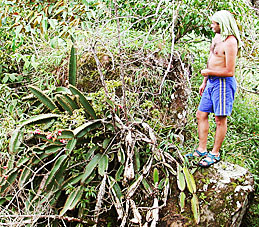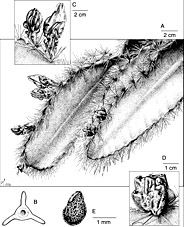 |
QUICK SEARCH
MO PROJECTS:
Africa
Asia/Pacific
Mesoamerica
North America
South America
General Taxonomy
Photo Essays
Training in Latin
America
MO RESEARCH:
Wm. L. Brown Center
Bryology
GIS
Graduate Studies
Research Experiences
for Undergraduates
Imaging Lab
Library
MBG Press
Publications
Climate Change
Catalog Fossil Plants
MO DATABASES:
W³MOST
Image Index
Rare Books
Angiosperm
Phylogeny
Res Botanica
All Databases
INFORMATION:
What's New?
People at MO
Visitor's Guide
Herbarium
Jobs & Fellowships
Symposium
Research Links
Site Map
Search
|
Draft Treatments | Guidelines | Checklist | Citing | Editors The Cutting EdgeVolume IX, Number 2, April 2002News and Notes | Leaps and Bounds | Germane Literature | Season's Pick SEASON'S PICK: Weberocereus frohningiorum 
 This Season's Pick is remarkable not only because it is particularly handsome (for its large, thick, 3-winged stems, numerous long, amber spines and copious flowering, it is the most robust Weberocereus species we know), but also because it is the first new species for the genus in over 35 years. Perhaps the species will also become remarkable for having stimulated the ensuing story. Although all of us are probably guilty of condemning plants and colleagues to cumbersome and ahh, inept names, this is certainly a case where we would have chosen something more handsome and descriptive of the plant itself, like maybe "amplissimus." In fact we did. And that's the end of the story. It began like this.... In May of 2001, INBio hot-shot Francisco (Chico) Morales, sent Manual co-editor Hammel (then in St. Louis) a scanned photo of a cactus that he said “has to be new!“ He had found it on a steep cliff, on limestone rocks deep in the Pacific slope region, south of San José, where so many interesting new taxa and new records have come to light in recent years. Although Chico knows this area well, we still know of only one (though quite large) individual, isolated and hidden over the downslope side of a rocky horse trail, passable to 4-wheel drive vehicles only in the summer. Soon after Hammel returned from St. Louis at the end of June, he and Chico visited the site together to get live material for illustration, to take photos, and to search for more individuals. By the end of August, their manuscript was well underway. A low, enduring, tremulous excitement was in the air about this wonderful new species. Our illustrator, Silvia Troyo, outdid herself with a superb illustration (above). Several cuttings rooted easily, and one with fruits was monitored to see them to maturity. Seeds developed and germinated, and the seedlings were babied into plantlets. Visions of following the new species publication with a sale of plants to the highest bidders, of fame and fortune (all in the name of science and conservation, of course), danced through our authors' daze. Serious and heated discussions about whether or not to reveal the exact locality in the publication (avid and lawless collectors, rampant among cactophiles, could eliminate this species in one trip), animated the normal drudgery of our day-to-day work, writing and editing Manual treatments. As is often the case with such matters, a simple, one-new-species manuscript became a synopsis for this small genus; all but three of the less-than-a-dozen species in the genus are endemic to Costa Rica, and all but the new one are epiphytic. Finally, on 1 March of this year, Hammel took the nearly complete manuscript and the illustration with him on one of his annual trips to MO. That weekend he spent in the herbarium, finalizing the distribution statements and specimen citations. On Monday morning, the manuscript was ready to hand over to Novon, but first Hammel went to say hello to Mike Grayum, who greeted him not with a hand shake, but with a photocopy of an article that had surfaced on the new journal shelves just the previous week: Eine neue Art aus Costa Rica: Weberocereus frohningiorum Ralf Bauer spec. nov. “Weren't you guys working on some new species of cactus?“ he said. According to Hammel, “The article, written in German, needed only a cursory glance from a distance of several feet, at the front page photo, to sink my heart... and our fine name!“ Several questions remain: was it renowned cactus collector Clarence Horich [see the Cutting Edge 1(2): 3, Apr. 1994] who sent the specimen to the Palmengarten in Frankfurt? If so, why didn't he send one to Cactaceae specialist Myron Kimnach (HNT), with whom he maintained a rich correspondence and collaboration, and who has published much about this genus? If not Horich, who did send it, and is its exact origin really unknown to the Palmengarten, or are they or someone else being protective of the locality? And finally, how long will it take us to get out of this funk? |
© 1995-2025 Missouri Botanical Garden, All Rights Reserved
4344 Shaw Blvd.
St. Louis, MO 63110
(314) 577-5100
Technical Support